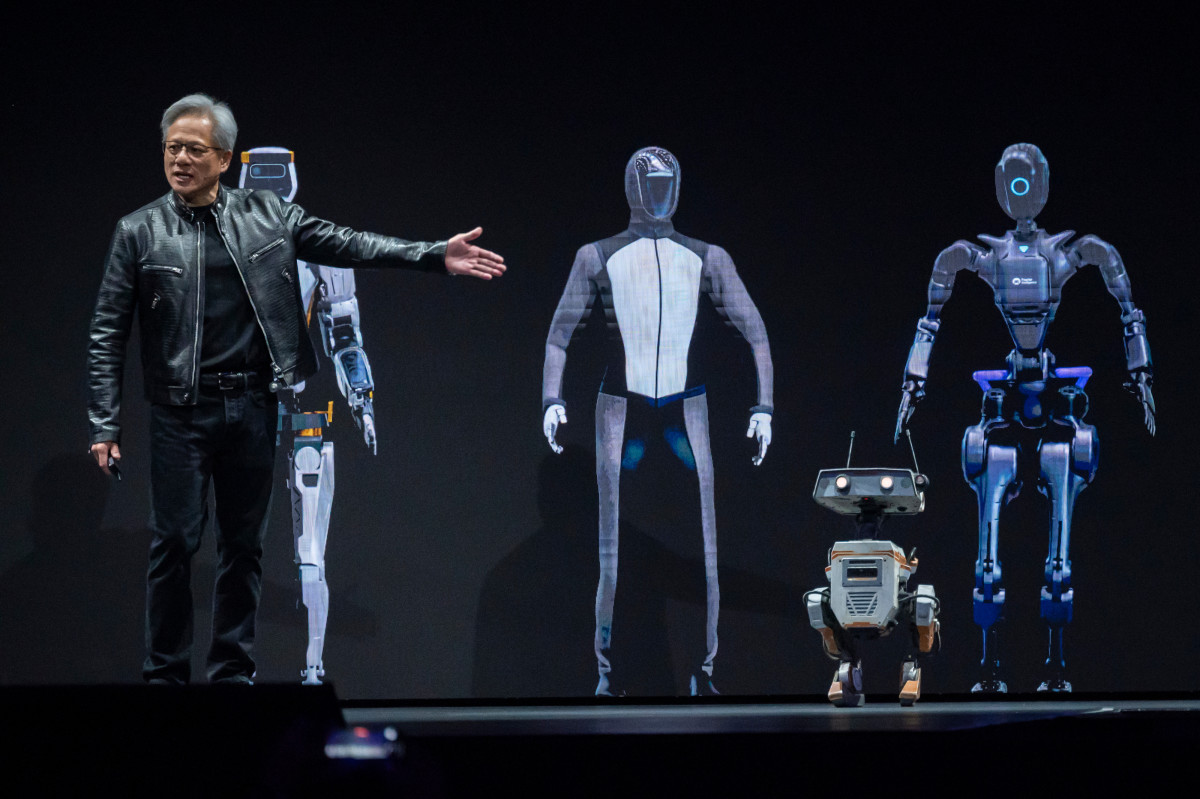
Fast Facts
- Nvidia on Monday announced a new AI model designed to power robots.
- The company at the same time unveiled a new computer designed to power that model.
The end of Nvidia CEO Jensen Huang's two-hour keynote address at the company's developer conference Monday was taken over by a handful of robots that walked out on stage, beeping and whistling at Huang before settling down to watch him finish the address.
The robots' appearance followed an announcement from Huang of a robotics project the company called Groot — which stands for Generalist Robot 00 Technology.
Related: Jensen Huang outlines a huge future for Nvidia
Groot refers to a new foundation model designed by Nvidia to bring artificial intelligence and robotics together; Huang said the model will enable robots both to understand natural language and to learn physical movements by observing and emulating humans.
"The soul of Nvidia: The intersection of computer graphics, physics, artificial intelligence," Huang said. "It all came to bear at this moment."
The model will be powered by a new computer — also unveiled at Monday's conference — called Jetson Thor, a GPU designed to power multimodal generative AI efforts.
The company's focus, detailed in the keynote, is on simulation training within this realm of robotics.
Nvidia did not divulge the data used to train this new model, nor did it discuss the energy usage or carbon footprint of the model or the Jetson Thor GPU.
Nvidia did not immediately respond to a request for comment regarding these points.
"2024 is the Year of Humanoid. There’s no robot hardware more general-purpose," Nvidia research manager Dr. Jim Fan said in a post on X. "We are all in."
Nvidia said in a statement that it is working with a number of humanoid robotics companies on this project, including Boston Dynamics, Figure AI, Fourier Intelligence, Sanctuary AI, Unitree Robotics and XPENG Robotics.
Related: In a blow to Tesla's Optimus, Microsoft, Jeff Bezos and Nvidia make a major new investment
Optimus, Figure and Elon Musk
A company notably absent from that list was Tesla (TSLA) , the Elon Musk-owned electric vehicle giant that has been working on humanoid, AI-powered robots (Optimus) for years.
Tesla's plan is to first introduce its Optimus robots as manufacturing workers in its car factories before making it available to the public as a metal butler.
Musk said in 2022 that "Optimus ultimately will be worth more than the car business and worth more than full self-driving. That’s my firm belief.”
Still, Tesla has yet to introduce the robots to its factories.
Figure, meanwhile, in January announced a commercial agreement with BMW to bring its humanoid robots to BMW's manufacturing facilities. At the end of February, the company announced that it had raised $675 million in a new funding round that included investments from Microsoft, Nvidia, OpenAI and Jeff Bezos.
The company now has a valuation of $2.6 billion.
As part of the investment round, Figure also announced a collaborative partnership with Microsoft and OpenAI, which resulted in the integration of OpenAI's software with Figure's robotic hardware.
With OpenAI, Figure 01 can now have full conversations with people
— Figure (@Figure_robot) March 13, 2024
-OpenAI models provide high-level visual and language intelligence
-Figure neural networks deliver fast, low-level, dexterous robot actions
Everything in this video is a neural network: pic.twitter.com/OJzMjCv443
Nvidia on Monday also joined the Open Source Robotics Foundation in its announcement of the creation of an Open Source Robotics Alliance, an initiative designed to "strengthen the governance of our open-source robotics software projects."
Contact Ian with tips and AI stories via email, ian.krietzberg@thearenagroup.net, or Signal 732-804-1223.
Related: The ethics of artificial intelligence: A path toward responsible AI







